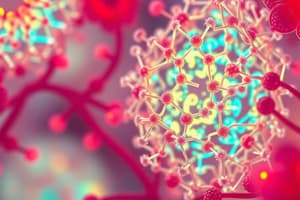Podcast
Questions and Answers
Qual é o tipo de microscópio que usa luz visível para iluminar as amostras?
Qual é o tipo de microscópio que usa luz visível para iluminar as amostras?
- Microscópio de luz branca
- Microscópio de luz (correct)
- Microscópio de contraste de fase
- Microscópio de fluorescência
Qual é a principal razão para manter a limpeza regular do microscópio?
Qual é a principal razão para manter a limpeza regular do microscópio?
- Para evitar que os[lençóis sejam riscados
- Para evitar que os lençóis sejam pintados
- Para evitar que os lençóis sejam danificados
- Para garantir o desempenho ótimo e prolongar a vida útil do microscópio (correct)
O que é possível observar com a microscopia?
O que é possível observar com a microscopia?
- Apenas a divisão celulare
- Apenas a migração celular
- A estrutura e o comportamento das células (correct)
- Apenas a forma das células
Por que é importante calibrar regularmente o microscópio?
Por que é importante calibrar regularmente o microscópio?
O que é possível fazer com a microscopia além de observar a forma das células?
O que é possível fazer com a microscopia além de observar a forma das células?
Qual é o tipo de microscópio que usa um feixe de elétrons para produzir uma imagem?
Qual é o tipo de microscópio que usa um feixe de elétrons para produzir uma imagem?
Flashcards are hidden until you start studying
Study Notes
Microscopy in Biology
Microscope Maintenance
- Regular cleaning and maintenance are essential to ensure optimal performance and extend the lifespan of the microscope.
- Clean the microscope lenses with a soft, dry cloth and avoid touching the lenses with bare hands.
- Store the microscope in a dry, cool place, away from direct sunlight.
- Calibrate the microscope regularly to ensure accurate measurements.
- Perform routine checks on the microscope's mechanical components, such as the stage and focus knobs.
Cell Observation
- Microscopy allows for the observation of cell morphology, structure, and behavior.
- Cells can be observed in their natural state or stained to enhance visibility.
- Microscopy techniques can be used to study cellular processes, such as cell division, migration, and signaling.
- Microscopy can be used to identify and diagnose cellular abnormalities and diseases.
Microscope Types
Light Microscopes
- Use visible light to illuminate samples.
- Include:
- Brightfield microscopes: use transmitted light to observe samples.
- Fluorescence microscopes: use fluorescent dyes to observe specific structures.
- Phase contrast microscopes: use differences in refractive index to observe samples.
Electron Microscopes
- Use a beam of electrons to produce an image.
- Include:
- Transmission electron microscopes (TEM): use a beam of electrons to image samples.
- Scanning electron microscopes (SEM): use a focused beam of electrons to produce a high-resolution image.
Specialized Microscopes
- Include:
- Confocal microscopes: use lasers to produce high-resolution, three-dimensional images.
- Super-resolution microscopes: use specialized techniques to achieve resolutions beyond the diffraction limit.
- Atomic force microscopes: use a physical probe to image samples at the atomic level.
Studying That Suits You
Use AI to generate personalized quizzes and flashcards to suit your learning preferences.




